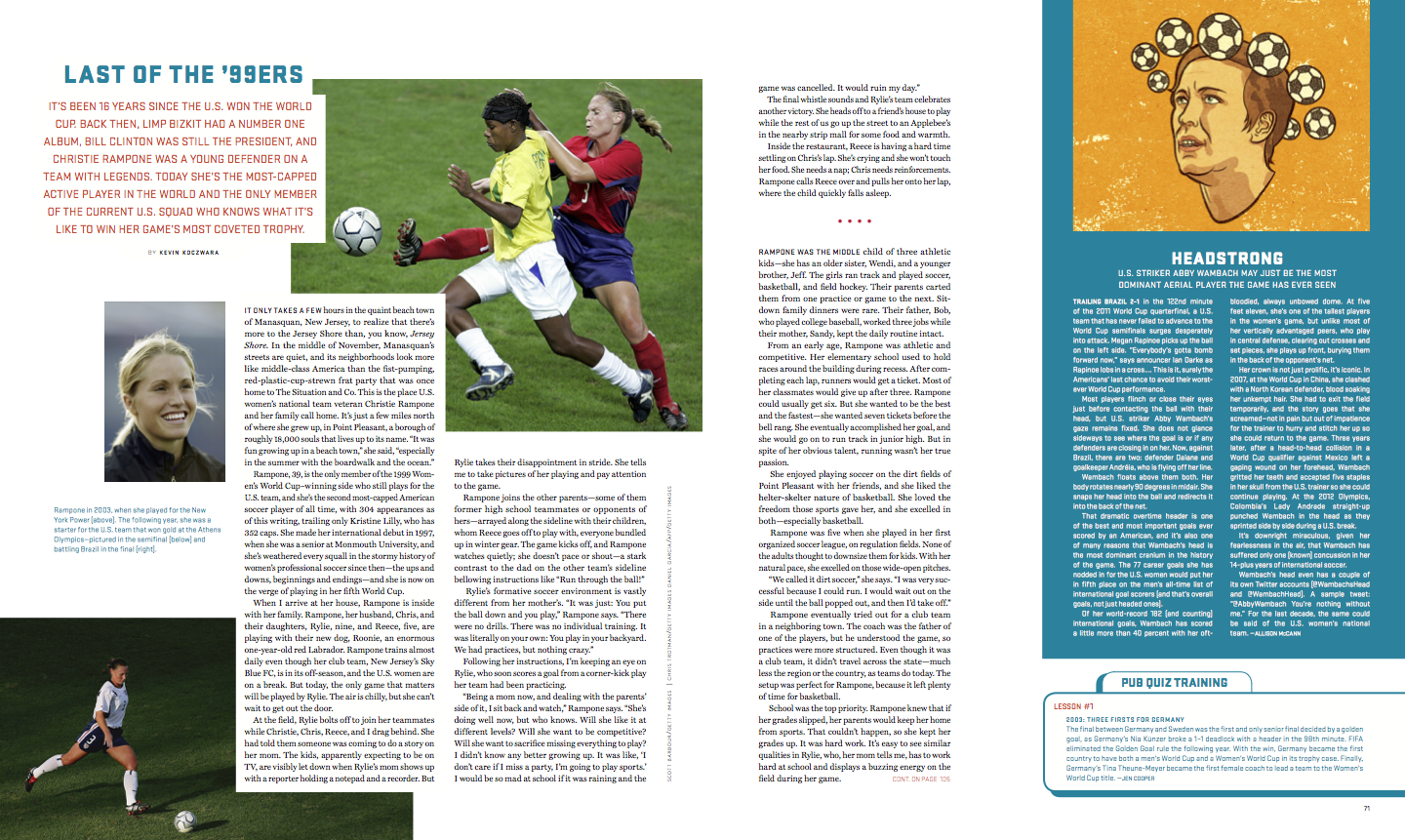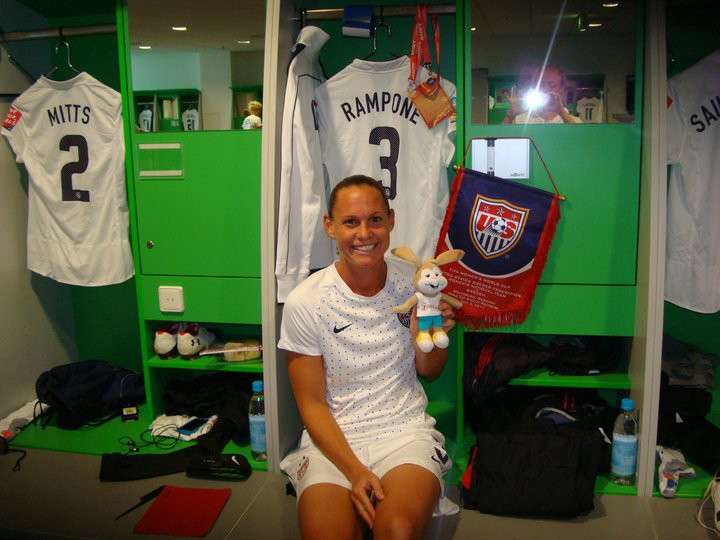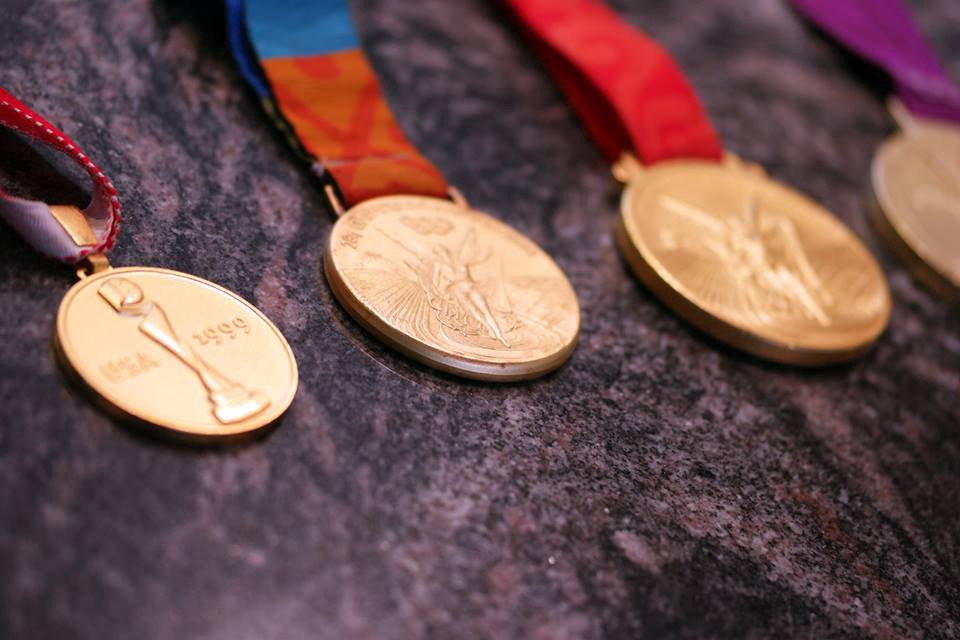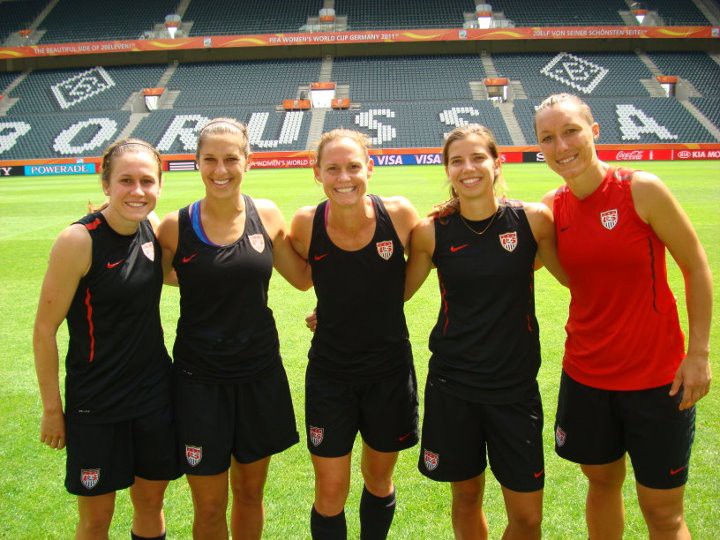A look back at one of American soccer’s greatest careers

Editor’s Note: This story originally appeared in Issue 8 of Howler, which came out before the Women’s World Cup in the summer of 2015. After the story ran, Rampone won her second World Cup as a member of the United States Women’s National Soccer. During the final, a 5–2 defeat of Japan, Rampone came on during the dying moments of the game and became the only 40-year-old to play in a World Cup (she had celebrated her 40th birthday 11 days earlier).
It only takes a few hours in the quaint beach town of Manasquan, New Jersey, to realize that there’s more to the Jersey Shore than, you know, Jersey Shore. In the middle of November, Manasquan’s streets are quiet, and its neighborhoods look more like middle-class America than the fist-pumping, red-plastic-cup-strewn frat party that was once home to The Situation and Co. This is the place U.S. women’s national team veteran Christie Rampone and her family call home. It’s just a few miles north of where she grew up, in Point Pleasant, a borough of roughly 18,000 souls that lives up to its name. “It was fun growing up in a beach town,” she said, “especially in the summer with the boardwalk and the ocean.”
Rampone, 39, is the only member of the 1999 Women’s World Cup–winning side who still plays for the U.S. team, and she’s the second most-capped American soccer player of all time, with 304 appearances as of this writing, trailing only Kristine Lilly, who has 352 caps. She made her international debut in 1997, when she was a senior at Monmouth University, and she’s weathered every squall in the stormy history of women’s professional soccer since then — the ups and downs, beginnings and endings — and she is now on the verge of playing in her fifth World Cup.
When I arrive at her house, Rampone is inside with her family. Rampone, her husband, Chris, and their daughters, Rylie, nine, and Reece, five, are playing with their new dog, Roonie, an enormous one-year-old red Labrador. Rampone trains almost daily even though her club team, New Jersey’s Sky Blue FC, is in its off-season, and the U.S. women are on a break. But today, the only game that matters will be played by Rylie. The air is chilly, but she can’t wait to get out the door.
At the field, Rylie bolts off to join her teammates while Christie, Chris, Reece, and I drag behind. She had told them someone was coming to do a story on her mom. The kids, apparently expecting to be on TV, are visibly let down when Rylie’s mom shows up with a reporter holding a notepad and a recorder. But Rylie takes their disappointment in stride. She tells me to take pictures of her playing and pay attention to the game.

Rampone joins the other parents — some of them former high school teammates or opponents of hers — arrayed along the sideline with their children, whom Reece goes off to play with, everyone bundled up in winter gear. The game kicks off, and Rampone watches quietly; she doesn’t pace or shout — a stark contrast to the dad on the other team’s sideline bellowing instructions like “Run through the ball!”
Rylie’s formative soccer environment is vastly different from her mother’s. “It was just: You put the ball down and you play,” Rampone says. “There were no drills. There was no individual training. It was literally on your own: You play in your backyard. We had practices, but nothing crazy.”
Following her instructions, I’m keeping an eye on Rylie, who soon scores a goal from a corner-kick play her team had been practicing.
“Being a mom now, and dealing with the parents’ side of it, I sit back and watch,” Rampone says. “She’s doing well now, but who knows. Will she like it at different levels? Will she want to be competitive? Will she want to sacrifice missing everything to play? I didn’t know any better growing up. It was like, ‘I don’t care if I miss a party, I’m going to play sports.’ I would be so mad at school if it was raining and the game was cancelled. It would ruin my day.”
The final whistle sounds and Rylie’s team celebrates another victory. She heads off to a friend’s house to play while the rest of us go up the street to an Applebee’s in the nearby strip mall for some food and warmth. Inside the restaurant, Reece is having a hard time settling on Chris’s lap. She’s crying and she won’t touch her food. She needs a nap; Chris needs reinforcements. Rampone calls Reece over and pulls her onto her lap, where the child quickly falls asleep.

Rampone was the middle child of three athletic kids — she has an older sister, Wendi, and a younger brother, Jeff. The girls ran track and played soccer, basketball, and field hockey. Their parents carted them from one practice or game to the next. Sit-down family dinners were rare. Their father, Bob, who played college baseball, worked three jobs while their mother, Sandy, kept the daily routine intact.
From an early age, Rampone was athletic and competitive. Her elementary school used to hold races around the building during recess. After completing each lap, runners would get a ticket. Most of her classmates would give up after three. Rampone could usually get six. But she wanted to be the best and the fastest — she wanted seven tickets before the bell rang. She eventually accomplished her goal, and she would go on to run track in junior high. But in spite of her obvious talent, running wasn’t her true passion.
She enjoyed playing soccer on the dirt fields of Point Pleasant with her friends, and she liked the helter-skelter nature of basketball. She loved the freedom those sports gave her, and she excelled in both — especially basketball.
Rampone was five when she played in her first organized soccer league, on regulation fields. None of the adults thought to downsize them for kids. With her natural pace, she excelled on those wide-open pitches.
“We called it dirt soccer,” she says. “I was very successful because I could run. I would wait out on the side until the ball popped out, and then I’d take off.”
Rampone eventually tried out for a club team in a neighboring town. The coach was the father of one of the players, but he understood the game, so practices were more structured. Even though it was a club team, it didn’t travel across the state — much less the region or the country, as teams do today. The setup was perfect for Rampone, because it left plenty of time for basketball.
School was the top priority. Rampone knew that if her grades slipped, her parents would keep her home from sports. That couldn’t happen, so she kept her grades up. It was hard work. It’s easy to see similar qualities in Rylie, who, her mom tells me, has to work hard at school and displays a buzzing energy on the field during her game.

Rampone blossomed into a star athlete at Point Pleasant Borough High. And that’s putting it mildly: In her senior year, Rampone — who was Christie Pearce then — led the Shore Conference in scoring in soccer, basketball, and field hockey. She finished her high school hoops career with 2,190 points — a school record that still stands. After being named New Jersey High School Female Athlete of the Year in 1993, Rampone attracted interest from some of the best college basketball programs in the nation, including Ohio State, Missouri, and Colorado.
But Rampone was a shy teenager who had never flown on an airplane. She was overwhelmed by the recruiting process. She decided to stay close to home, choosing Monmouth, which is just 20 miles up the Garden State Parkway from Point Pleasant. Her sister, Wendi, was on the soccer team at Monmouth, and the basketball coach was open to Rampone playing soccer in the fall as long as it didn’t get in the way of her basketball obligations.
“I was able to not have to make a decision [about playing] both sports, go to school for free, get an education,” Rampone says. “I wanted to be a school teacher for special education, and they had a great program.”
So began the soccer career of Monmouth’s starting point guard. Rampone would ring up 79 goals and 54 assists in 80 games for the school. And people noticed. In January 1997, during her senior year, she was with her Monmouth basketball teammates on their way home from a win over Long Island University when her coach, Sue Dekalb, called her to the front of the bus and delivered a message that would change her life. There’d been a fax from U.S. Soccer coach Tony DiCicco inviting Rampone to California to train with the U.S. women’s national team. Was this a joke? Neither Rampone nor DeKalb knew what to make of it.

After the initial surprise, it dawned on player and coach that Rampone had a decision to make. U.S. Soccer wanted a yes or a no. A yes would mean Rampone would have to leave her basketball teammates, in midseason, while they were gunning for a spot in the NCAA Tournament. There was also the matter of her scholarship. Basketball paid Rampone’s way through college, not soccer.
Both DeKalb and the Monmouth athletic director wanted Rampone to stay. “There was a lot of talk and a lot of tears and a lot of uncertainty,” Rampone recalls. She eventually decided to accept DiCicco’s invitation, and when she spoke to the basketball team to let them know, some of her teammates understood and some didn’t. But Rampone realized this was too big of an opportunity to pass up.

When she arrived at that first U.S. camp, Rampone received an entire set of USWNT gear, and she gazed out at the beautiful training complex, sparkling under the San Diego sun. This wasn’t some college all-star game or a cattle-call tryout, she realized. This was big-time.
On her flight from the Newark airport, Rampone had carried a bag of luggage that included laundry detergent and fabric softener. She hadn’t known that U.S. Soccer would take care of her laundry while she was in camp. And that wasn’t the only thing she didn’t understand about the experience awaiting her.
“It was a shock, because I was in my basketball world,” Rampone says. “And now here I am watching clips of them winning a gold medal in ’96. Now I’m like, ‘What am I doing here?’ and realizing there are only a few new faces besides the past team.”
To add to her sense of intimidation, one of her roommates was none other than Mia Hamm.
Rampone just tried not to embarrass herself during practice. She kept her mouth shut and worked hard. She made it through the first two days as a forward, a position stacked with the likes of Hamm, Cindy Parlow Cone, Tiffeny Milbrett, and Michelle Akers, who led the 1991 World Cup in scoring with 10 goals.
Eventually, DiCicco decided to try Rampone as a defender. He thought her speed and athleticism could be effective at right back, where the team lacked depth at the time.
“I was like, ‘Anything I can do to be on this team,’” says Rampone.
When training shifted to full-field games, Rampone showed what she could do. She wasn’t yet the great defender she would become, but she showed clear signs of promise, and her blazing speed enabled her to get up and down the right side.
After her 10 days with the team, she flew home with two bags — one stuffed with brand-new U.S. gear, the other containing unused laundry detergent. Rampone had made her mark.
She signed her first contract with U.S. Soccer, in 1997, for $4,000. She worked part-time as a waitress on the Jersey Shore after college while training and playing in the W-League, first for the Central Jersey Splash and then the Buffalo FFillies and New Jersey Lady Stallions. Whenever the USWNT had a training camp or a match, she’d get the call and head out.
But the game grew unexpectedly during the next two years — so much so that 1999 World Cup organizers had to switch venues to accommodate larger-than-expected turnouts.
The ’99 final between the U.S. and China took place at the Rose Bowl in front of 90,185 fans, a record crowd for women’s sports. Brandi Chastain’s iconic celebration of her cup-winning penalty was splashed on the cover of Sports Illustrated and beamed out across the globe. Hamm became a household name, soon to be followed by Wambach, Alex Morgan, and Hope Solo.
Rampone only played 17 minutes in that landmark 1999 World Cup, but her game, like women’s soccer in general, was on the upswing. She would go on to play for the U.S. in the 2003, 2007, and 2011 World Cups as well as at the 2000, 2004, 2008, and 2012 Olympics. She’s won three consecutive Olympic gold medals with the team, the last two — in 2008 and ’12 — as captain.
“She’s right there with the greatest of stars,” DiCicco told the Newark Star-Ledger in 2012. “Maybe Mia Hamm has a place by herself. But the others? Julie [Foudy], Joy [Fawcett], Kristine [Lilly], and Brandi Chastain? Christie belongs in that group.”
She exceeds that group in longevity and maybe in toughness as well. In the middle of the 2009 WPS season, Rampone was named player-coach of Sky Blue FC and led the team to victory in the title game — after which she revealed she was three months pregnant with Reece and had undergone surgery for a ruptured ovarian cyst right before being named player-coach.

She has come back from an ACL injury, and she’s been living with Lyme disease since 2011. She’s stayed the course through the comings and goings of WUSA and the WPS, and she’s currently a mainstay in the NWSL.
If there’s one game she would like to have back, it’s the 2011 World Cup final against Japan, which the U.S. lost on penalties. It was her first time captaining the World Cup team, and she has said she may never get over the sting of that loss.
But now, 16 years after her World Cup debut, after all of the highs and lows, Rampone and her USWNT peers inhabit a different world from the one in which she began her career. They’re all full-fledged professionals. Waitressing is a distant memory.

Earlier in the day, Rampone and I had stood in her basement, Rylie and Reece playing with toys on the floor, while a projector — a gift from Wambach, who Rylie tells me is her best friend — beamed a show from the Disney Channel onto a screen. The decor was rec-room-meets-sports-bar-meets-hall-of-fame-exhibit. Medals hung on hooks behind a bar at the back of the room. Plaques, pictures, jerseys, and other mementos from Rampone’s 18-year career covered the walls.
On my way home from New Jersey, I kept coming back to those basement walls plastered with memorabilia. There’s one section of the room that belongs to her husband, Chris, and it’s devoted to former New York Yankees relief pitcher Mariano Rivera. Chris loves Rivera. The soft-spoken Panamanian was the greatest closer of all time, but he never quite became a pop-culture star like many of his teammates. You didn’t see him in the gossip pages. He went about his business with quiet consistency and steely resolve. When his coaches asked him to switch positions — from starter to reliever — he not only accepted the change but flourished in the new role. Additionally, he had tremendous longevity, playing for 19 years, until the age of 43. At the end of his career, he received the kind of accolades he deserved. And he took it in stride, humble and grounded to the end. If somebody told you he’d shown up to his first spring training toting his own laundry detergent, you’d believe it.
It’s how I imagine Rampone will go out when she finally calls it quits. But, just like Rivera, she won’t let any of that shake her focus. In Canada, she has one more massive job to do.

